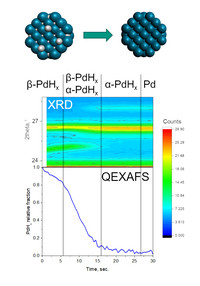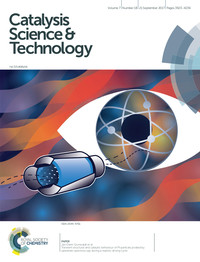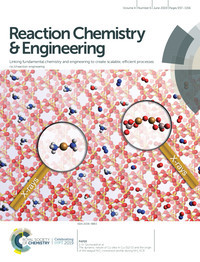In-Situ-Spektroskopie/Synchrotron-Methoden
The ´in situ spectroscopy/synchrotron methods´ team which is located both at IKFT and the Institute for Chemical Technology and Polymerchemistry (ITCP) applies synchrotron based X-ray absorption spectroscopy and complementary techniques to analyze structural properties of catalysts and their catalytic performance. Structure-activity relationships obtained in this way play a key role in the development and optimization of catalytically active materials. Important application areas are fine chemistry, materials for renewable energy technologies, biomass conversion and emission control.
Many catalysts change under reaction conditions. Dynamic structural changes occur within subsecond time intervals (e. g. milliseconds during the ignition of a reaction), minutes, hours (e. g. activation) or days (deactivation). To identify the structure of active sites under working conditions and analyze their dynamic behavior, catalysts and catalytic processes are investigated under reaction conditions also denoted “in situ” or “operando”. A number of sample cells and test setups have been specially designed e. g. for high temperature, high pressure, gas and liquid phase reactions.
The in situ experiments are equipped with gas and liquid dosing systems and a mass spectrometer, FTIR, or micro_GC for on-line analysis of reaction products. Combined set-ups for complementary techniques (e.g. XAS-XRD, XAS-DRIFTS) simultaneously provide information about the crystalline and X-ray amorphous structure and surface species. Special focus is further laid on time resolved and spatially resolved studies using microscopic and tomographic techniques.
Group members frequently perform X-ray absorption spectroscopic and X-ray microscopic experiments at KIT Synchotron (CAT beamline), PETRA III at DESY, SLS, SOLEIL, ESRF and other synchrotron radiation sources. A new beamline dedicated to catalysis research and operated by IKFT in close collaboration with Institute for Beam Physics and Technology (IBPT) and the Institute for Nuclear Waste Disposal (INE) provides state-of-the-art infrastructure for catalysis research with hard X-rays at the KIT Synchrotron.
In situ characterization under reaction conditions:
- Infrared spectroscopy
- Infrared thermography
- Raman spectroscopy
- UV-vis spectroscopy
- X-ray diffraction
- synchrotron based techniques:
- x-ray absorption spectroscopy (XANES, EXAFS)
- x-ray emission spectroscopy (XES)
- resonant inelastic x-ray scattering (RIXS)
- X-ray microscopy
- ptychography
Large-scale projects:
- CAT-ACT beamline (dedicated to Catalysis and Actinide research) at ANKA, designed for photon energies up to 60 keV
|
QEXAFS-XRD combination reveals the mechanism of Pd hydride decomposition. |
High pressure (100 bar) continuous flow reactor installed at the CAT-ACT beamline. |
|
|
Following transformations of Cu sites in a zeolite catalyst depending on local chemical environment |




